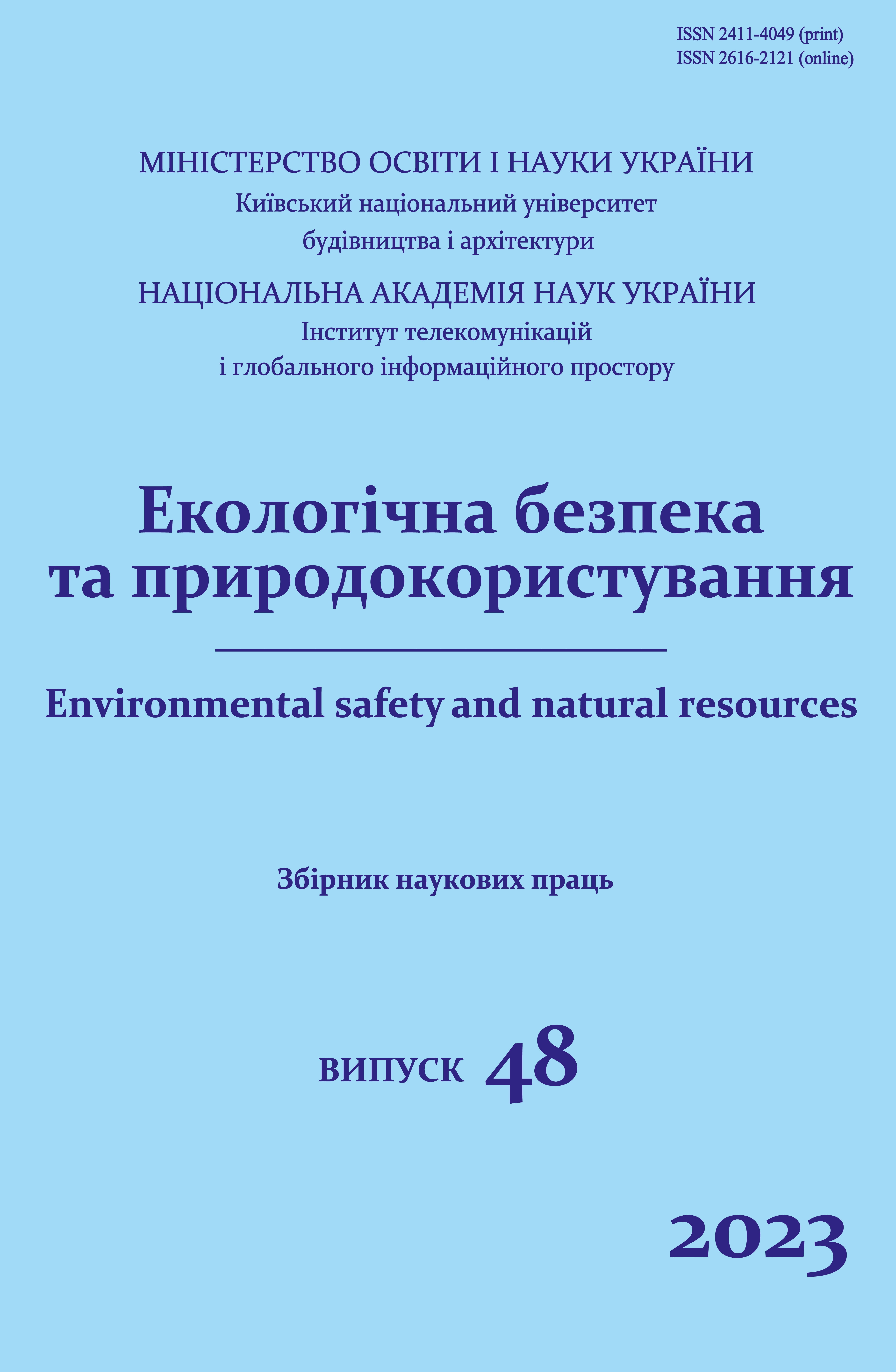Analysis of the potential of the city of Pokrovsk for the accumulation and use of atmospheric precipitation
DOI:
https://doi.org/10.32347/2411-4049.2023.4.48-61Keywords:
rainfall, urban wastewater accumulation system, alternative water supplyAbstract
The problem of water shortage in the city of Pokrovsk, Donetsk region, requires the search for alternative sources of water supply, especially for the needs of industry and agriculture. Atmospheric precipitation is considered as an alternative source. However, at the stage of choosing and developing a method of managing rainwater from an urbanized area and implementing technical means for its accumulation, storage, and use, it is important to assess the quantitative indicators of stormwater runoff. Research is aimed at substantiating the possibility of using atmospheric precipitation as an auxiliary source of water supply for industrial-communal, domestic, and agricultural needs based on statistical determination of the dynamics of precipitation on the territory of the city of Pokrovsk. Changes in rainwater runoff parameters were determined based on the analysis of the meteorological data archive for the period 1985–2022.
The study found that the city of Pokrovsk has the potential for wastewater accumulation. The city has a tendency to increase the frequency of high-intensity storms with a 34.89% increase in the average height of the precipitation layer for one abnormal rainy day. Over the period 2004–2022, the average annual and annual rainfall per rainy day increased slightly by 0.56% and 6.23%, respectively, compared to the same period in the previous year (1985–2003), while the average number of rainy days per year decreased by 5.25%.
The dynamics of annual volumes of surface wastewater indicates the need to improve the city's rainwater accumulation system, which should provide a 35% increase in the current flow rate of abnormal rainfall and eliminate the risk of flooding. To do this, the storage capacity should be increased by deepening the city pond "Nulyovka" and the ridge located downstream. It is expedient for private households to create individual sediment accumulators.
References
Carollo, M., Butera, I. & Revelli, R. (2022). Water savings and urban storm water management: Evaluation of the potentiality of rainwater harvesting systems from the building to the city scale. Public Library of Science (PLoS), №17(11), e0278107. https://doi.org/10.1371/journal.pone.0278107
March, H., Hernández, M. & Saurí, D. (2015). Assessing domestic water use habits for more effective water awareness campaigns during drought periods: A case study in Alicante, eastern Spain. Nat. Hazards Earth Syst. Sci. 15, 963–972.
Ajayi, A.R. & Ugwu, C. C. (2008). Rainwater Harvesting for Agriculture and Domestic Supply in Enugu North Agricultural Zone, Nigeria. Journal of Agricultural Extension, 12(1). https://doi.org/10.4314/jae.v12i1.47022
Сampisano, A., Butler, D., Ward, S., Burns, M.J., Friedler, E., DeBusk, K., Fisher-Jeffes, L.N., Ghisi, E., Rahman, A. & Furumai, H. (2017). Urban rainwater harvesting systems: Research, implementation and future perspectives. Water Res, 115, 195–209. https://doi.org/10.1016/j.watres.2017.02.056
Villar-Navascués, R., Pérez-Morales, A. & Gil-Guirado, S. (2020). Assessment of Rainwater Harvesting Potential from Roof Catchments through Clustering Analysis. Water. 12(9), 2623. https://doi.org/10.3390/w12092623.
Meteorological archive Pokrovsk. Retrieved from https://www.meteoblue.com [in Ukrainian].
Methodical recommendations for ensuring effective removal of surface water. Order of the Ministry of Housing and Communal Affairs of Ukraine dated 23.12.2010 No. 470. (recommendations in the field of housing and communal services). Retrieved 30.05.2023 from https://zakon.rada.gov.ua/rada/show/v0470738-10#Text [in Ukrainian].
Zhuk, V.M., Malyovany, M.S., Mysak, I.V., Tymchuk, I.S., Mushalla, D. & Pichler, M. (2021). Temporal and spatial unevenness of rainfall in modeling surface runoff from urbanized areas. Scientific bulletin of NLTU of Ukraine, 3(5), 67–73 [in Ukrainian]. https://doi.org/10.36930/40310510
Kostenko, V., Zavialova, O., Chepak, O. & Pokalyuk, V. (2018). Mitigating the adverse environmental impact resulting from closing down of mining enterprises. Mining of Mineral Deposits, 12, 105–112. https://doi.org/10.15407/mining12.03.105
Vovk, L.I. & Trofymchuk, Yu.A. (2018). Comparison of the volumes of surface runoff from typical residential microdistricts of large cities, determined in accordance with regulatory documents of Ukraine. Bulletin of the Lviv Polytechnic National University. Series: Theory and practice of construction, №904, 3–9 [in Ukrainian].
Rules for using systems of centralized communal water supply and drainage in populated areas of Ukraine. (2010). K.: Ministry of Housing and Municipalities of Ukraine. Retrieved from https://zakon.rada.gov.ua/laws/show/z0936-08#Text [in Ukrainian].
Arias, P.A., Bellouin, N. & Coppola, E. (2021). The Physical Science Basis. Contribution of Working Group I to the Sixth Assessment Report of the Intergovernmental Panel on Climate Change Summary for Policymakers. Technical Summary, 33–144.
Tavrel, M., Kostenko, V., Bohomaz, O., Kostenko, T., Zemlianskyi, О. & Pidhornyy, M. (2022). Recirculating Airlift for Aeration of Shallow Water Bodies. Ecological Engineering & Environmental Technology, 23(5), 177–187. https://doi.org/10.12912/27197050/152114
Kostenko, V., Tavrel, M., Bohomaz, O., Zavyalova, O., Kostenko, Т., Myhalenko, К. & Kostyrka, О. (2022). Experimental Testing of Water Body Aeration Airlift Technology. Ecological Engineering & Environmental Technology, 23(3), 184–192. https://doi.org/10.12912/27197050/147635
Barabash, O.Yu., Sych, Z.D. & Nosko, V.L. (2008). Care of vegetable crops. Kyiv: Innovation [in Ukrainian].
Downloads
Published
How to Cite
Issue
Section
License
Copyright (c) 2023 Bohomaz O.P., Kostenko V.K., Tavrel M.I., Hlavatskykh K.M.

This work is licensed under a Creative Commons Attribution 4.0 International License.
The journal «Environmental safety and natural resources» works under Creative Commons Attribution 4.0 International (CC BY 4.0).
The licensing policy is compatible with the overwhelming majority of open access and archiving policies.

